In-Depth with Mac OS X Lion Server
by Andrew Cunningham on August 2, 2011 8:00 AM ESTIf you’ve played around with iOS management at all, you might be familiar with the iPhone Configuration Utility that Apple has been maintaining for awhile now. Basically, it creates XML files with .mobileconfig extensions that can be downloaded to iOS devices and used to configure most of the device’s settings, from email to VPN to password requirements.
Lion Server and the Profile Manager build on this, giving administrators a centralized interface with which to create and deploy .mobileconfig files (which now support Lion as well). To turn on the Profile Manager, open up Server.app and flip the switch.
Since we’ve already configured our Open Directory, Profile Manager should start up without much fuss. Note that if you have other services running on your server that you’ve configured with Server.app (such as Mail, VPN, iCal, etc.), these will automatically be available to all of your users as a default configuration profile - that profile’s name and settings can easily be changed, and it can be turned off entirely if you want.
Now, open the Profile Manager (either by clicking the link in Server.app or typing <yourservername>/profilemanager into a browser and log in as the Directory Administrator account you made earlier. As an administrator, you should see all the users and groups with which you’ve populated your directory.
By default, every user on your directory who goes to <yourserveraddress>/profilemanager and logs in will be able to download and install the “Settings for Everyone” profile connecting them to your hosted services. That’s certainly not everything you can do, though - click a user or a group’s profile to bring up the profile editor.
This window shows you all of the configurable options for your devices - some apply to iOS, some apply to OS X, and many apply to both. Aside from connecting your clients to your hosted services, you can also control just about every major setting in either OS: password requirements, how the Dock looks and acts, whether iOS users can install apps to their devices, and more. Profile Manager refers to each configurable subsection as a “payload.”
Go ahead and make a change or two - I want to make my iOS users use a passcode to lock their devices, while is available under Passcode - and when you’re done, click OK. You should now see an entry for every payload you configured under Settings. Cick Save to make your changes permanent, or Revert to discard.
Now, on my iPhone (you can use a Mac for this step too, as long as there’s an applicable setting to manage), I’ll navigate to the Profile Manager and login as a member of the group I just edited. Now, in addition to the Settings for Everyone option, the Settings for Workgroup profile is also ready to download and install.
Note that any profile installed this way will need to be refreshed manually in the event of updates.
For those of you who are interested in more active management of devices, you’ll have to go back to Server.app and enable Device Management.
You’ll need an SSL certificate to enable secure communication between your devices and your server - this isn’t going to work without a signed SSL certificate, at least not that I saw (feel free to correct me if I’m wrong in the comments), but we can still go through Device Management’s basic implementation.
Next, you’ll have to install a separate Apple Push Notification certificate to enable Push Notifications for your server and its clients. The only place to get one is from Apple, and the only way to do it is to associate an Apple ID with your server, though it doesn't cost anything extra.
If everything checks out, you should be told that your server meets all the Profile Manager requirements. Now, go ahead and start the Profile Manager by clicking the link in the lower right-hand corner of the window.
Now, if I take my iPhone to the Profile Manager site, there’s a second tab available with a giant “Enroll” button visible.
Clicking Enroll will establish a link between your device and the server - this will allow your server admin to update settings on your device, send out notifications, and even remotely lock and/or wipe your device in the event of theft.
Keep in mind that all of this is true both for iOS devices and Macs running Lion. While some of the iOS elements in Lion feel awkward and grafted on, Profile Manager really shows the promise of merging the two operating systems: it’s not just about making them look and act the same, but it’s also about making their management similar enough that it reduces time and money spent wrangling different management tools to manage the different OSes.
Since we’ve already configured our Open Directory, Profile Manager should start up without much fuss. Note that if you have other services running on your server that you’ve configured with Server.app (such as Mail, VPN, iCal, etc.), these will automatically be available to all of your users as a default configuration profile - that profile’s name and settings can easily be changed, and it can be turned off entirely if you want.
Now, open the Profile Manager (either by clicking the link in Server.app or typing <yourservername>/profilemanager into a browser and log in as the Directory Administrator account you made earlier. As an administrator, you should see all the users and groups with which you’ve populated your directory.
By default, every user on your directory who goes to <yourserveraddress>/profilemanager and logs in will be able to download and install the “Settings for Everyone” profile connecting them to your hosted services. That’s certainly not everything you can do, though - click a user or a group’s profile to bring up the profile editor.
This window shows you all of the configurable options for your devices - some apply to iOS, some apply to OS X, and many apply to both. Aside from connecting your clients to your hosted services, you can also control just about every major setting in either OS: password requirements, how the Dock looks and acts, whether iOS users can install apps to their devices, and more. Profile Manager refers to each configurable subsection as a “payload.”
Go ahead and make a change or two - I want to make my iOS users use a passcode to lock their devices, while is available under Passcode - and when you’re done, click OK. You should now see an entry for every payload you configured under Settings. Cick Save to make your changes permanent, or Revert to discard.
Now, on my iPhone (you can use a Mac for this step too, as long as there’s an applicable setting to manage), I’ll navigate to the Profile Manager and login as a member of the group I just edited. Now, in addition to the Settings for Everyone option, the Settings for Workgroup profile is also ready to download and install.
Note that any profile installed this way will need to be refreshed manually in the event of updates.
Device Management
For those of you who are interested in more active management of devices, you’ll have to go back to Server.app and enable Device Management.
You’ll need an SSL certificate to enable secure communication between your devices and your server - this isn’t going to work without a signed SSL certificate, at least not that I saw (feel free to correct me if I’m wrong in the comments), but we can still go through Device Management’s basic implementation.
Next, you’ll have to install a separate Apple Push Notification certificate to enable Push Notifications for your server and its clients. The only place to get one is from Apple, and the only way to do it is to associate an Apple ID with your server, though it doesn't cost anything extra.
If everything checks out, you should be told that your server meets all the Profile Manager requirements. Now, go ahead and start the Profile Manager by clicking the link in the lower right-hand corner of the window.
Now, if I take my iPhone to the Profile Manager site, there’s a second tab available with a giant “Enroll” button visible.
Clicking Enroll will establish a link between your device and the server - this will allow your server admin to update settings on your device, send out notifications, and even remotely lock and/or wipe your device in the event of theft.
Keep in mind that all of this is true both for iOS devices and Macs running Lion. While some of the iOS elements in Lion feel awkward and grafted on, Profile Manager really shows the promise of merging the two operating systems: it’s not just about making them look and act the same, but it’s also about making their management similar enough that it reduces time and money spent wrangling different management tools to manage the different OSes.
Open Directory: Creating Users and Groups and using Workgroup Manager
Address Book, iCal, iChat, and Mail


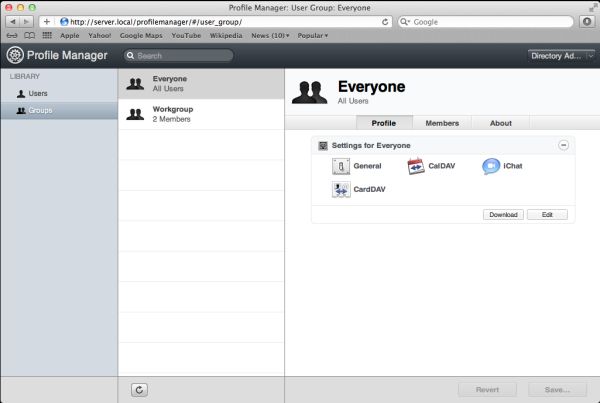
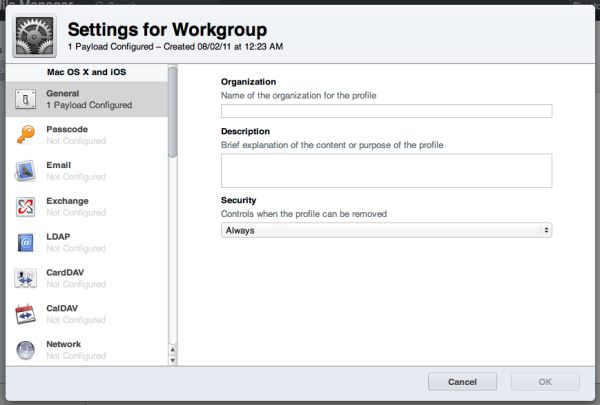
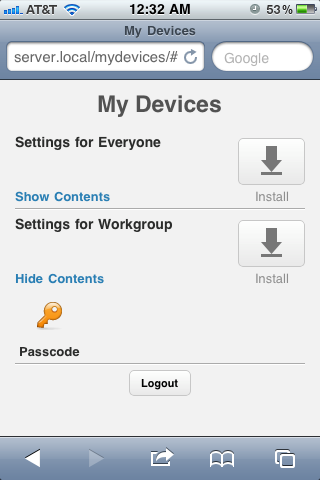
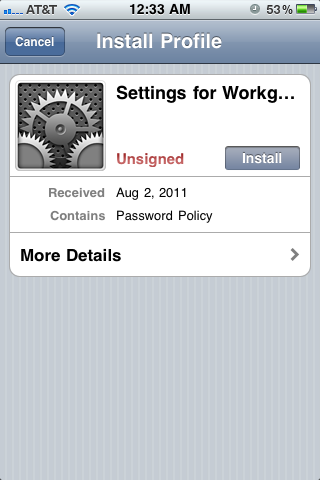
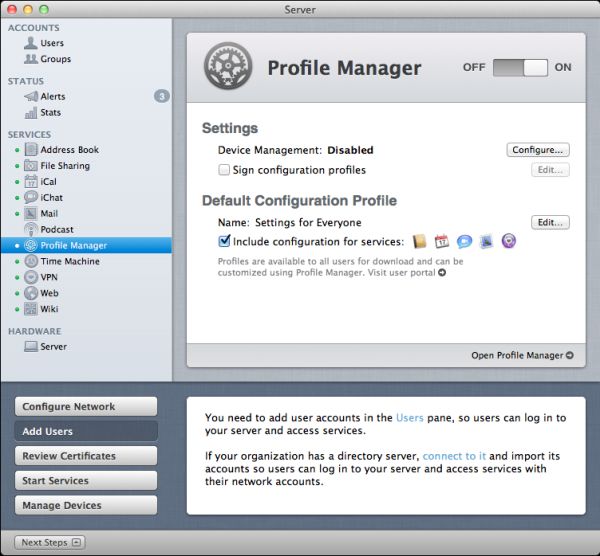
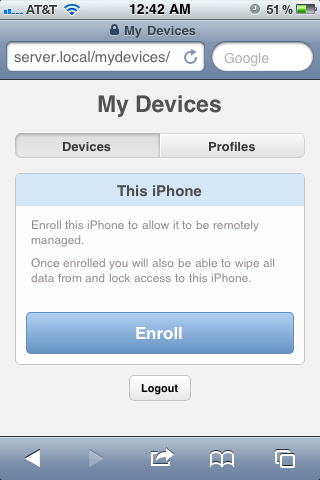








77 Comments
View All Comments
the_engineer - Thursday, August 4, 2011 - link
Indeed, and that's the plan, assuming nothing else I like more comes along. I was really sort of tantalized by the possibility of software RAID in OSX, and still haven't been able to get a straight answer on it. Currently it is looking like it's a no go.tff - Tuesday, August 2, 2011 - link
As a home user, I've been frustrated by the inability to have two users edit a shared calendar in OS X/iOS without using 3rd party software.How would it differ using Lion server to accomplish this rather than Lion and iOS 5 clients using iCloud?
Typical Mac home user- iPhones, iPads, Mac laptops.
Omegabet - Tuesday, August 2, 2011 - link
You can install server.app on a client. Just copy the app over from the server. The first time you launch it, choose connect to a server. It will then run server.app from your client. Otherwise it will upgrade lion to the server version. This was recommended in the apple documentation (can't remember where though).qiankun - Tuesday, August 2, 2011 - link
One instance I found frustrating is that non-HSF+ volumes like NTFS and exFat cannot be accessed from other computers using SMB or AFP. You can add the volume to the file sharing list, pick whatever protocol you like, but when you try to access it you'll get an error. Same thing applies to the bootcamp partition.I like to use NTFS or exFat on external drives, for simple fact that whenever needed you can simply disconnect them from the mac server and plug into a PC. I know there are software that allows reading HSF+ partitions on windows, but it's not installed everywhere, very unlikely if you want to use the drive on a random computer you or your friend uses.
damianrobertjones - Tuesday, August 2, 2011 - link
Windows Home Server. That's all I have to add.justinf79 - Friday, August 5, 2011 - link
WHS isn't even in the same league...rs2 - Tuesday, August 2, 2011 - link
I've used a number of different wiki solutions, and the one included on OS X Server is a toy compared to most other popular wikis. There's just no comparison between the OS X wiki and something like Confluence or MediaWiki.gamoniac - Tuesday, August 2, 2011 - link
At first glance, this looks impressive, given the price tag and the myriad of features provided. However, the author should note the huge maintenance costs of this at best rudimentary product. Anyone who has used Apache or IIS 7 knows the Lion web server is years away from catching up.What good is a cheap product if you have to to spend, say, 40 hours, trying to get something to work. The TCO is too high even at $10/hour, and even for home users.
gamoniac - Tuesday, August 2, 2011 - link
PS: Good article nonetheless. Thank you AT. Keep them coming!repoman27 - Wednesday, August 3, 2011 - link
What's good about a cheap product with a myriad of features is that if even one or two work as advertised out of the box, it was worth it. If not, you're only out $50. I configured Snow Leopard Client on a MacBook Pro to work as a NetBoot / NetRestore server because I happened to find that functionality useful, and although it was trivial to do so, I'm perfectly inclined to shell out the $50 for Lion Server going forward rather than monkey around with another client version.In general, you're right though, it's stupid to cheap out on a capital expenditure and then spend an order of magnitude more trying to get someone who knows what they're doing to make it work.
Really, though, who doesn't spend at least 40 hours setting up a new server for the first time?